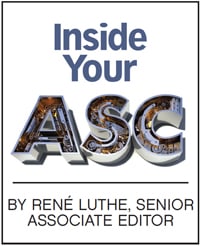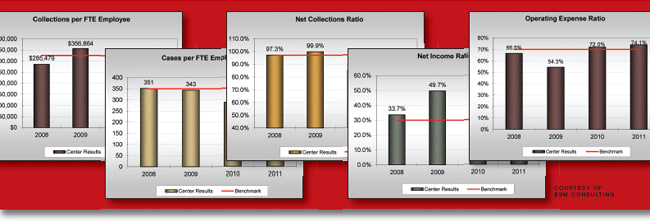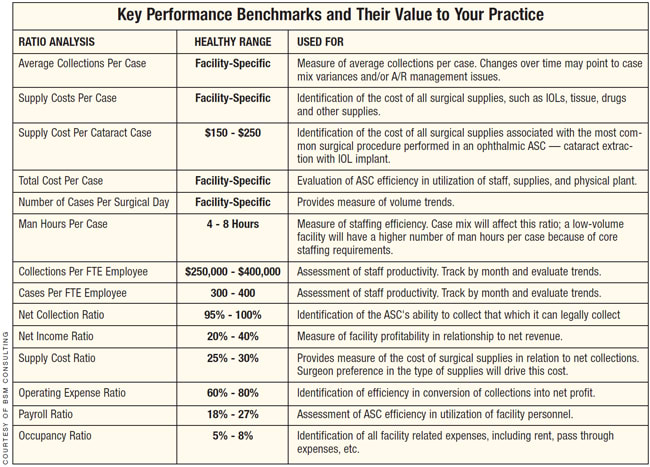ASC Benchmarking: Knowledge is Power
Taking your facility's vital signs brings real benefits—and it's easier than most people think.

The benefits of both internal and external benchmarking for ambulatory surgery centers would seem to be clear: to see the cold facts of your ASC laid bare as a business and a clinical undertaking, to set goals and to measure improvements from year to year. Yet according to many of the people whose business it is to monitor ASCs, benchmarking remains a frequently overlooked tool for a large percentage. How large? While benchmarking has increased in recent years, both the Outpatient Ophthalmic Surgery Society and the Ambulatory Surgery Center Association estimate that about half of ASCs still aren't doing it. ASCA's Debra Stinchcomb, RN, CASC (certification demonstrating a comprehensive understanding of the knowledge and skills that the role of an ASC administrator requires), notes that accrediting bodies, including the Joint Commission on Accreditation of Healthcare Organizations and the Accreditation Association for Ambulatory Health Care, generally list the failure to benchmark in their top five or six citations of deficiencies. Even financial benchmarking, which would seem harder to forego for the economic health of the facility, is underused, according to John Goehle, MBA, CASC, a former board member for the ASCA.
If so many ASCs continue to ignore benchmarking and still prosper, is it really as beneficial as it's cracked up to be? Sadly (for healthcare administrators who feel they already have enough paperwork to do), the answer is yes, insist ASC-industry watchers. They also have two pieces of good news to go along with that pronouncement, however: (1) benchmarking is easier than you think, and (2) the potential benefits are substantial.

Why the Reluctance?
The slow adoption of benchmarking can be traced to a few simple factors, according to those who monitor the industry. But they note that closer examination of these perceived problems reveals ready solutions.

■ ASCs aren't sure how to begin or are unaware of the resources available to them. It may seem daunting to start something new without a frame of reference to guide you. Fortunately, the ASCA and OOSS offer benchmarking surveys that can be accessed online through their Web sites (asca.org and ooss.org, respectively). OOSS's annual Benchmarking Initiative is specifically designed for ophthalmic ASCs and is open to all that have an ophthalmic component. The organization began offering benchmarking five years ago as an industry service, yet Kent L. Jackson, PhD, OOSS's vice president of member research and development, finds that it is still news to many facilities. ASCA offers two surveys, the Outcomes Monitoring Project and the ASC Financial Benchmarking Survey, available to both single- and multi-specialty ASCs.
Additionally, Ms. Stinchcomb notes that large, populous states such as California, Florida, Ohio and New York are starting statewide benchmarking initiatives. All these alternatives offer assistance for facilities that may be confused about getting started, she says.
■ It is perceived as a huge burden on staff. Dr. Jackson reports that at OOSS workshops offered at the annual AAO and ASCRS meetings, those who still aren't benchmarking frequently cite perceived difficulty as a major reason why. Ms. Stinchcomb finds that as well. “We tell people that it's not this cumbersome PhD project. You are comparing what you are doing to facilities just like you.”
Even beginner benchmarkers should require no more than four hours to gather and enter the required data, according to Dr. Jackson—two to four hours to track down the information and approximately 15 minutes to enter it. “Facilities that have done it before require even less time,” he says. He adds that the project often requires two or three staff members: A clinical director or nurse, an administrator and a business manager.
Once you develop systems for tracking and put the process in place, says Beth Hurley, RN, owner of Ophthalmic Surgery Resources, Inc., and a current OOSS board member, “It's very easy to pull up reports and follow your progress.”
■ Many ASC administrators don't have a strong business background. According to Mr. Goehle, their forte, not surprisingly, tends to be the clinical arena. Often the result is that they tend to set a benchmarking survey aside, intending to get to it later. “It's not something that they are terribly familiar with and maybe, frankly, they are much more interested in the operational benchmarking anyway,” Mr. Goehle says. But the rewards for benchmarking are great, he maintains, so he urges administrators to involve the facility's accountant in the process.
Really—You'll Be Glad You Did
The benefits of benchmarking have been addressed before, but as English essayist Samuel Johnson said, “People need to be reminded more often than they need to be instructed.” The lag in ASCs actually performing benchmarking suggests the adage holds true here as well. So at the risk of repetition, here are some of the best arguments for taking the plunge.
■ A common surprise to ASCs once they do begin benchmarking is that their facility is not doing as well as they'd thought. These unpleasant surprises often come in the areas of numbers of surgical cases per day, cases done per full-time employee and man-hours per case, according to Maureen Waddle, senior consultant at BSM Consulting. Don't let this put you off, though, Ms. Hurley warns; it's an opportunity for growth as you learn why other ASCs are performing better. “You may think you're getting a great price on laundry service, but then you find out you are paying substantially more than most ASCs,” she explains. “You want to find out what they are doing that you are not.”
■ You see your facility through a more complete lens, notes Kent Jackson of OOSS. Many ASCs report the value of benchmarking as recognizing the extent of detail and the interrelatedness between different measures, such as the relationship between FTE staff ratios, operating costs and payroll ratios. “They've never really thought about that,” Mr. Jackson says. “Intuitively, they know those are connected, but they've never seen measures organized in this manner.”
■ Benchmarking enables facilities to demonstrate their success. Whether they are competing with their own past performance or that of another ASC, facilities can document, for accrediting agencies and prospective patients, their improvements.
■ Last but not least: CMS is crafting standards by which they will measure ASCs in the future. If an ASC isn't compliant, Ms. Waddle warns, they could be removed from the Medicare panel. “In an ophthalmic ASC, that's the bulk of your business!”
Get Help
Organizations such as ASCA and OOSS do more than offer a template; they help ASCs obtain a clear reflection of where the enterprise stands. They address a common source of confusion by letting you know what you should be measuring and what other facilities are measuring, Ms. Waddle points out. And because a multispecialty ASC has different considerations than an eyecare ASC, OOSS's ophthalmology-only approach speaks to the specialty's unique characteristics. Chief among these, Ms. Waddle notes, is the focus on cataract surgery, a less costly procedure that lends itself to more efficient procedure turnaround. Additionally, OOSS offers further precision by breaking down results according to the numbers of procedures a facility performs (its categories are: under 1,000; 1,000 to 3,000; over 3,000).
The clarity organizations and other outside consultants provide on the definitions of benchmarks is crucial. Beginning the process with a correct understanding of the various definitions involved directly affects the legitimacy of the findings. As Ms. Waddle explains, “When we are looking at benchmarks, we are always looking at ratios. So we are always dividing numbers in order to have a standard. If we have wrong definitions anywhere in the process, it's just not going to work.”
Definitions that vary from facility to facility not only don't help, they cause confusion and alarm. Ms. Waddle cites a recent difficulty surrounding premium IOLs. At ASCs, consumer demand has led to growth, she says. Their expense is substantial and because CMS has decreed what can be collected from the patient for these IOLs, there is little to no profit for the surgery center—the cost of the lens is $895 and the surgery center is supposed to reduce its charge amount by $150 for the amount that Medicare allows as part of the normal cataract surgery facility fee. Medicare limits the center to charge patients the actual cost of IOL plus handling fee less $150. But with the patient paying the practice about $1,000 per eye, that is where the profits are… in the practice.
“If centers haven't split out those expenses, their supply costs have gone up dramatically and they wonder what has happened,” Ms. Waddle says. “If standard IOL expenses and premium IOL expenses aren't separate, how can you compare IOL costs between centers when one does not perform any premium IOL cases and the other has surgeons implanting premium IOLs 20% of the time? It's a challenge to make sure we are all defining things the same way so that when you do start comparing, it's apples to apples.”
Should a facility find itself floundering, OOSS offers help. Dr. Jackson sends an e-mail reminder to ASCs that have started the benchmarking survey but didn't complete it. “As soon as they've entered their information and they've clicked the finish icon, I automatically receive a report so that I can review their responses.” Once he has reviewed the data, he sends the ASC his feedback, with a request to review it and send him any further changes.
As for financial benchmarking, help is yours for the asking as well: ASCA offers finance seminars every 18 months. Mr. Goehle reports that the organization began offering the seminars 10 years ago in response to a perceived weakness in finance and accounting knowledge in many administrators. And while the ASCA also offers a book, Finance & Accounting for ASCs, Mr. Goehle believes that any effort to familiarize oneself with the business side of ASC life is bound to help. “We accountants speak a different language. Just like the clinical people speak in acronyms, so do we—usually just to get back at them,” he jokes.
| Tracking Patient Cases and Related Time and Personnel Resources |
|---|
| Ophthalmic ASC owners looking to gain a better understanding of their practice efficiency can get a helping hand from OOSS's annual Benchmarking Initiative. Here is a sampling of measures used to evaluate facility management of surgical cases that, combined with cost, revenue and other process measures, enable ASC teams to improve efficiency while managing for quality. Cataract Case Cycle Time: Three years of results (2008, 2009 and 2010) reveal incremental increases in average preop time (from patient check-in to arrival in OR) from 52 minutes in 2008 to 54 minutes in 2009. Early 2010 results reveal an estimated 60 minutes in 2010, suggested a continuation of this trend. Intraop time (in surgery) and Postop time (in recovery) have both held steady. 
Average Measures Per Case: The 2009 results reveal the following case measures related to operational efficiency and assignment of personnel. The 2010 results are still coming in: • Average Cases Performed Per Surgical Day = 21 • Average Cases Performed Per Year Per Full Time Equivalent Employee = 309 • Average Employee Hours Per Case = 6.7 |
Pick Your Indicators
For those still intimidated by the amount of work benchmarking requires, experts agree on the wisdom on starting small. A modest approach can still yield valuable information.
“Start with one single thing that you are going to benchmark and make it something that's pertinent to your practice, something you or your physicians really want to look into,” advises Ms. Hurley.
BSM's Ms. Waddle advocates a similar modest beginning to build confidence while still getting critical data. “Rather than being intimidated and doing nothing, pick five benchmarks, even if it's only your accounts receivable numbers,” Ms. Waddle agrees. She believes that operating expenses ratio and staff expense ratio are also good markers to begin tracking. “P&L statements should be set up so that it's easy to get to those benchmarks.”
ASCA recommends beginning with the indicators specified in CMS's proposal for mandatory quality reporting (published on June 30, with a final rule expected in November). “You're going to have to submit those things to CMS anyway,” says Ms. Stinchcomb. These measures include:
• Patient burns.
• Patient fall in the ASC.
• Wrong site, wrong side, wrong patient, wrong procedure, wrong implant.
• Hospital transfer/admission.
• Prophylactic antibiotic (cephalosporin), with a surgical site infection rate measure to be added in 2013 (go to http://www.cms.gov/apps/media/ for the complete regulation).
Most of the items, Ms. Stinchcomb notes, are already measured by both ASCA and OOSS.
Facilities that are already measuring those indicators won't require much time to submit them. Those that are not reviewing could likely find that their entire Quality Assurance and Performance Improvement (QUAPI) program be reviewed and commented on during a certification survey. QUAPI is one of the main areas of citation that Chrissy Boore, RN, a consultant with Progressive Surgical Solutions, LLC, sees in notices of deficiency. “Submit that data and get into a system of submission and looking at them,” urges Ms. Stinchcomb. “CMS really is looking for ASCs to have very robust quality programs.”
Dr. Jackson says that patient cycle time is one measure worth scrutinizing, noting that it serves as both a clinical and business benchmark. “How quickly you can turn cases is an efficiency measure, it's a patient satisfaction measure and it's a surgeon satisfaction measure.” While OOSS currently restricts that measure to cataract procedures, given that those constitute 60% or more of the typical ophthalmic ASC's cases, the group plans to expand the measure to other procedures. Certain oculo-plastic surgeries and retinal procedures are under consideration, Dr. Jackson says.
In the area of financial benchmarking, he notes that FTE measures are well worth a look. Facilities should know how many hours are spent on business matters ir relation to clinical matters. “More efficient facilities are spending their money where their money is made. So analysis of your FTE allocation is an interesting one,” Dr. Jackson says.
A Little Perspective, Please
Once an ASC does begin external benchmarking, it's important to keep context in mind as you look at results for other ASCs. Ms. Waddle says that she always tells her new ASC clients not to panic if they end up falling outside the “healthy range” for facilities overall. She emphasizes that these ranges are only statistical averages derived from data over a period of years. There could be good reasons an ASC's indicator falls outside of that range.
Ms. Stinchcomb of ASCA agrees. She cites the example of a facility that is looking at unscheduled patient transfers from an ASC to a hospital. While both OOSS and ASCA have found two per 1,000 patients to be the average, one benchmarking may reveal that a particular ASC had four for that period. But it doesn't necessarily mean that that ASC is doing something wrong. “Maybe that ASC is in a population that is very noncompliant,” she says. “Maybe they don't take their meds at home or they are just a sicker population. So maybe four is acceptable in that population.” Alternately, though, the ASC may find that it is not assessing the patients as much up front as it could. Benchmarking gives facilities the chance to find the why behind their numbers.
“As you get more adept at benchmarking—say, after doing it internally for one or two years and seeing your own trends, then you can set your goals,” Ms. Waddle says.
Little Effort, Big Rewards
Once you develop systems for tracking the data, Ms. Hurley points out, it is easy to pull up reports as often as you like and monitor your progress. Decisions—about staff employment, patient work-up or which procedures to offer—can be based on facts rather than feelings or suspicions.
“Let's face it, we are all competitive, and we all like to see our name as doing the best. So if you are at the bottom of some measure, it really inspires you to improve.” OM








